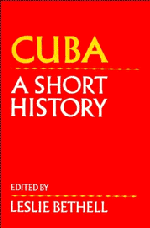1 - Cuba, c. 1750–c. 1860
Published online by Cambridge University Press: 05 June 2012
Summary
The Spanish colony of Cuba in the mid-eighteenth century was a largely forested, half unmapped island. It was known both to Spaniards and their enemies among other European empires primarily as the hinterland to Havana. That famous port had been built in the 1560s in a natural harbour on the north of the island to act as a depot from whence the Spanish treasure fleet could pick up a large naval escort. The few intrepid travellers who penetrated into the interior would have observed that the fauna of Cuba was friendly: there were no snakes, few big reptiles and no large wild animals. The indigenous Indian population – Tainos or Ciboneys – was held to have been absorbed or had died out, though in the unfrequented East of the island a few Taino villages survived. Some ‘white’ Spanish (or criollo) families had some Indian blood – including the Havana grandees, the Recios de Oquendo family.
About half the Cuban population of 150,000 or so lived in the city of Havana, where malaria and yellow fever frequently raged. Most of the rest lived in a few other towns, such as Santiago de Cuba, the seat of an archbishop, Puerto Príncipe, which boasted a bishopric, Sancti Spiritus, Trinidad, Matanzas and Mariel. None of these reached 10,000 in population. Rising above these cities, or near them, were a number of sixteenth-century castles and churches. In Havana three fortresses – la Fuerza, el Morro and la Punta – had all been built to guard the port.
- Type
- Chapter
- Information
- CubaA Short History, pp. 1 - 20Publisher: Cambridge University PressPrint publication year: 1993
- 2
- Cited by



